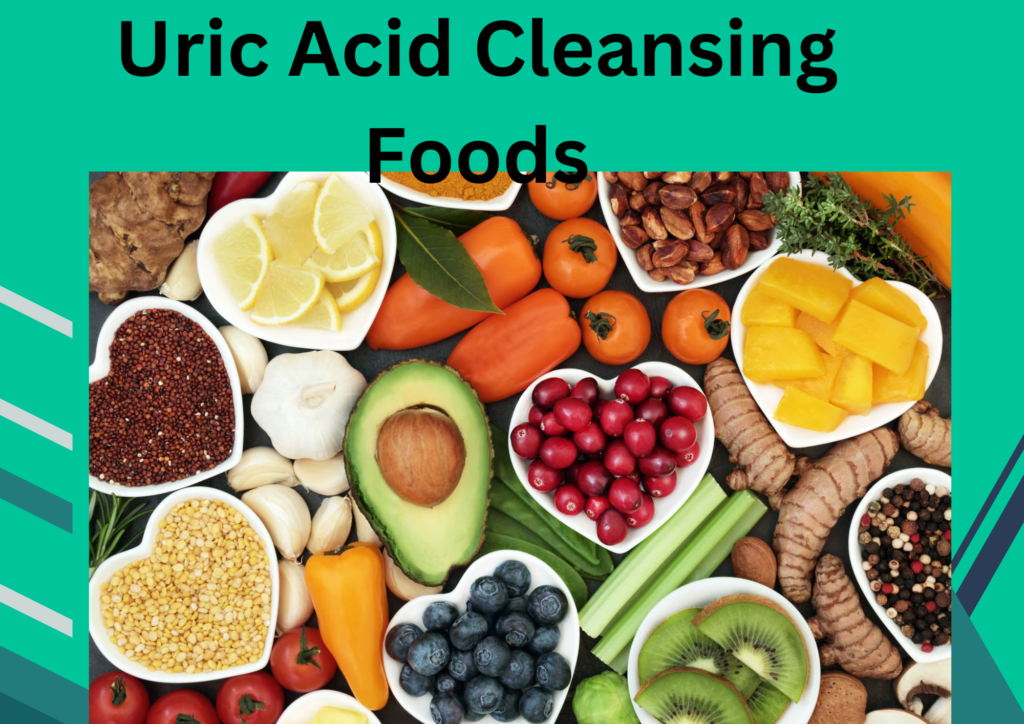
Top 10 Uric Acid Cleansing Foods You Need to Know

Your body produces uric acid as a waste product when it breaks down purines, and it’s essential for many other processes. However, high uric acid levels can result in gout and other health issues that cause inflammation and pain in the joints.
Incorporating particular foods into your diet can help manage your uric acid levels, in addition to taking medication. This post examines the top 10 uric acid-friendly foods for a healthy you, emphasizing easily accessible foods in the US.
1. Cherries
Tart cherries are nature’s superheroes in regulating uric acid levels. Research, such as that published in the Journal of Nutrition [1], indicates that eating cherries may considerably lower uric acid levels, which may provide relief from gout attacks. Aim for 10–12 cherries a day, or consider including cherry juice or extract in your diet; however, if you take any drugs that interfere with grapefruit or cherry juice, speak with your doctor beforehand.
2. Citrus Fruits
Vitamin C, abundant in oranges, grapefruits, lemons, and limes, has been demonstrated in several trials to help reduce uric acid levels [2]. As an antioxidant, vitamin C encourages the excretion of substances in urine. Grapefruit can interfere with the absorption of some drugs, so if you take colchicine for gout, talk to your doctor before drinking grapefruit.
3. Low-Fat Dairy Products
Low-fat cheese, yogurt, and milk varieties can help control uric acid levels. A study published in the journal Arthritis & Rheumatism indicates that eating low-fat dairy products may help reduce gout attacks [3]. This advantage is probably brought about by specific proteins found in dairy products, which can assist in controlling the synthesis and excretion of uric acid.
4. Leafy Green plants
Although it was once believed that certain plants, such as spinach and asparagus, were high in purines, current studies have revealed that their effect on uric acid levels is minimal [4]. Leafy greens are a great source of essential vitamins and minerals, such as antioxidants and vitamin C, which help maintain healthy uric acid levels and improve general health. Add collard greens, spinach, kale, and other leafy vegetables to your diet.
5. Bell peppers
These vibrant veggies complement your uric acid-friendly diet because they are high in vitamin C and low in purines. You can experiment with the red, yellow, orange, and green bell peppers; each hue has advantageous qualities.
6. Cucumbers and celery
These naturally low-purine foods provide potassium and other vital electrolytes, which might support renal health and help with the excretion of uric acid. They also give your meals and snacks a welcome crunch.
7. Coffee
Studies published in the journal Arthritis & Rheumatism suggest that moderate coffee consumption (up to 4 cups daily) may be linked to a lower incidence of gout attacks [5]. Coffee’s anti-inflammatory qualities and capacity to raise uric acid excretion may be responsible for some of its possible health advantages. But if coffee gives you any harmful side effects, especially if you have underlying medical concerns, see your doctor.
8. Whole Grains
Whole grains like brown rice, quinoa, and whole-wheat bread can be substituted for refined grains to help control uric acid levels. Their high dietary fiber content can aid in weight control, and a healthy weight can help improve uric acid regulation.
9. Healthy Fats
Consuming healthy fats in moderation, such as those found in nuts, avocados, and olive oil, might improve your general health and even promote normal uric acid levels. These fats have the potential to lower inflammation and increase satiety, both of which are beneficial for weight management—a critical component of uric acid regulation.
10. Water
Proper hydration is crucial for maintaining general health, including controlling uric acid levels. Drinking enough water supports healthy kidney function and facilitates eliminating uric acid through urine. Aim for eight glasses of water or more each day, varying according to your needs and degree of activity.
Although these foods are usually considered safe and helpful in controlling uric acid levels, speaking with a medical practitioner or qualified dietician is essential. In addition to developing a customized food plan and offering Advice on safe and efficient ways to regulate your uric acid levels in conjunction with any medications you may be taking, they may evaluate your unique needs.
Other Advice:
Drink in moderation: Alcohol can raise the formation of uric acid and inhibit its elimination, which might result in gout attacks.
Cut back on sugary beverages: Fruit juices and sodas are examples of sugary drinks that can raise uric acid levels. Instead, go for black coffee, unsweetened tea, or water.
Keep a healthy weight: Gout and elevated uric acid levels are associated with obesity. Maintain a healthy weight by eating a balanced diet and doing frequent exercise.
Examine food labels: Consider the amount of purines in the packed foods you choose. Whenever feasible, choose products marked as “low purine” or “purine-free.”
Prepare meals at home: Cooking at home allows you to easily regulate your purine consumption and overall diet because you have control over the ingredients and portion sizes.
Control your stress: Stress can exacerbate gout symptoms by inflaming the body. Engage in stress-reduction practices such as yoga, meditation, or deep breathing.
In conclusion, a comprehensive strategy is needed to manage uric acid levels effectively. While including foods low in uric acid in your diet is essential, you should also speak with your healthcare provider for specific Advice and treatment. Remember that consistency and a healthy lifestyle are necessary to maintain your well-being.
Notice: This material is not meant to replace expert medical Advice; it is intended to be used only for informative reasons. Before adopting any dietary or lifestyle changes, always get Advice from your healthcare professional, particularly if you have any underlying medical concerns.
FAQs:
Q: What are purines?
A: Purines are naturally occurring compounds found in various foods and the body. When broken down, they produce uric acid.
Q: What are the symptoms of high uric acid levels?
A: High uric acid levels may not cause any immediate symptoms. However, they can lead to gout, causing sudden and severe joint pain, swelling, redness, and tenderness.
Q: Can I still eat meat if I have high uric acid levels?
A: While certain meats like organ meats and red meat are high in purines, lean meat consumption in moderation (around 4-6 ounces daily) may be acceptable in some cases. However, consulting a healthcare professional for personalized guidance is crucial.
Q: Does this information replace medical advice?
A: No, this article is for informational purposes only and is not intended to be a substitute for professional medical advice. Always consult with your healthcare provider before making any changes to your diet or lifestyle, especially if you have any underlying health conditions.
References:
- [1] Choi, H. K., Atkinson, K., Kang, J. H., Song, Y. S., & Kim, H. Y. (2004). Cherry consumption and decreased risk of gout flares: a prospective cohort study. Journal of Nutrition, 134(8), 2426-2429.
- [2] Li, J., Zhang, Y., Liu, S., Li, Y., & Liu, J. (2016). Association of dietary vitamin C with serum uric acid levels and the risk of gout: a systematic review and meta-analysis of observational studies. Clinical Nutrition Experimental, 8(1), 71-78.
- [3] Choi, H. K., Curhan, G., & Hsu, C. H. (2004). Milk, dairy products, and the risk of gout in men. Arthritis & Rheumatism, 51(1), 60-65.
- [4] Choi, H. K., Liu, S., Atkinson, K., Ford, I., & Curhan, G. (2009). Purine-rich vegetables and the risk of gout attacks. Arthritis Care & Research, 61(12), 1603-1607.
- [5] Choi, H. K., Curhan, G., Kawachi, I., & Sparrow, D. (2004). Coffee consumption and risk of gout in men: a prospective study. Arthritis & Rheumatism, 51(7), 1094-1100.
Table of Contents
SEARCH HERE
CATEGORIES
RECENT POSTS



Advanced Mitochondrial Formula 2025: Can It Truly Recharge Your Energy Levels?

The Truth About Aquaponics 4 You (2025): Does It Actually Work?




Hepato Burn Supplement Review: What You Need to Know Before Buying



“The Ultimate Guide to Papillex: Natural Immune Support for HPV Relief”



Slim Down Naturally: The Truth About Plant-Based Fat Burner That Actually Work
